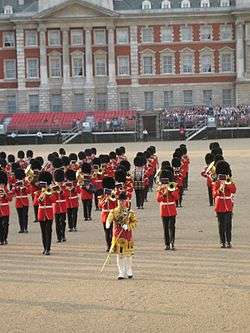Band of the Grenadier Guards
| Band of the Grenadier Guards | |
|---|---|
|
The band on Horseguards parade in London in 2008 | |
| Background information | |
| Also known as | Band of the Grenadier Guards |
| Origin | London, England, United Kingdom |
| Website | Home of the Grenadier Guards Band |
The Band of the Grenadier Guards is the oldest of all of the bands in the British Army, with a history dating back over 330 years.
History
In 1685 Charles II allowed the band to maintain 12 "hautbois" (oboe) players.[1] His death in 1685 was so significant for the band that until the Second World War, the Bass Drummer (known officially as The Regimental Timebeater), wore a black armband in mourning of the king's death.
The size of the ensemble has changed over time, starting off with between twelve and nineteen players, in the 18th century to a peak in numbers by the end of the 1970s of seventy musicians. Today there are 42 band members.
In 1872, the Band of the Grenadier Guards were the first British uniformed soldiers to enter the United States of America since the War of 1812. In the modern era, it last toured the US in 2003, when it gave performances over a period of three months, at over sixty venues, visiting forty states. The Band often tours overseas and has visited Belgium, Denmark, Italy, the Netherlands, Switzerland, Germany, Bosnia, and Australia.
The Band was given the freedom of the City of Lincoln on 8 May 2008.[2]
King Charles II restored not only the Monarchy to England but patronage of the arts, not least by laying the foundations of the Band of the Grenadier Guards when he commissioned players to the First Regiment of Foot Guards in 1685. The Regiment was to become known as the Grenadier Guards after their victory on the battlefield at Waterloo.
The Band of the Grenadier Guards has been filling the streets of London with music and colour for over three centuries, a truly historic sound and sight. It is symbolic and emblematic of London and the UK's history. The Band has served 15 monarchs over 325 years with dedication and pride. It has been present at all the major royal occasions: births, coronations, weddings and funerals.
The Band has been a witness to all London's key historic events, both tragic and joyful. It raised morale during the darkest hours of the Second World War; its uplifting music ushered in a new beginning at the coronation of the present queen.
The "British Grenadiers" March is one of the most recognizable and memorable tunes in the world, part of Britain's musical heritage. One of the band's admirers during the 18th century was George Frideric Handel. He demonstrated this by presenting the march from Scipio to the regiment before he included it in his opera of that name when it was first performed in 1726. George II gave Handel the task of scoring the Music for the Royal Fireworks, most commonly performed with strings, for the king's own musicians, who were wind players from his foot guards. Handel would have undoubtedly come into contact with musicians from the Grenadier Guards during the first performance at Vauxhall Gardens in 1749.
Throughout Britain's history the music of the Grenadier Guards has been the backdrop to its national life and identity. It represents Britain's constancy, dignity and artistry.
Band membership duties
Musicians currently in the band have secondary roles in the British Army as chemical decontamination assistants, medics and drivers.
The band is based at Wellington Barracks in St James's, London.
Key personnel
- Director of Music: Major Philip Stredwick
- Bandmaster: WO1 Sarah Marinescu
- Band Sergeant Major: WO2 Mark Buckley
Historical key personnel
- Lt. Dan(iel) Godfrey MVO (1831–1903), bandmaster (1856 - 1896)
Ensembles
There are several ensembles within the Band of the Grenadier Guards:
- Concert Band
- Marching band
- Dance band
- Big Band
- Fanfare Trumpet Team
- 18th Century Ensemble
Other ensembles include:
- Orchestras
- These include a range from a String Quartet, to a Chamber Orchestra
- Dinner Trios and Quartets also number among the band's ensembles.
Events
The Band of the Grenadier Guards plays regularly for many events. Some of these occasions that are most famous are listed below, although this is not a comprehensive list.
- Beating Retreat
- Changing of the Guard
- The Festival of Remembrance
- Trooping of the Colour
- Investitures
- State visits
The band also performs at other non-military events such as Henley Regatta, Royal Ascot, the FA Cup Final and international rugby matches and opened the 2002 Commonwealth Games in Manchester. The Band of the Grenadier Guards also visits schools to take part in musical concerts and workshops.
See also
References
- ↑ "Droit History of the Grenadier Guards Band". Retrieved 2008-10-28.
- ↑ "Official City Of Lincoln Press release". Retrieved 2008-10-28.
